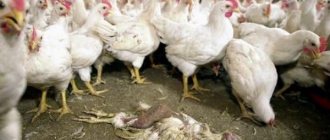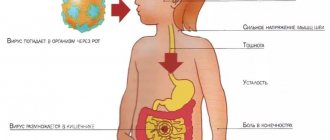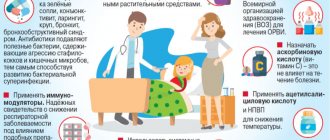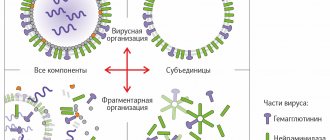Swine flu - symptoms and treatment
The reservoir and source of H1N1 influenza are infected pigs and sick people. Patients are contagious not only during the acute period of the disease, but also during recovery - they are able to excrete the virus within 2-3 weeks from the onset of the disease (the more severe the illness, the longer the virus is excreted).
The mechanism of transmission of the swine flu virus is standard for all influenza viruses. The infection is transmitted by airborne droplets when inhaling moisture and dust particles containing the pathogen. Less commonly, infection occurs through household items on which viral particles have settled.
The virus is released by a sick person or animal by coughing, sneezing, breathing, and, in the case of an infected person, by talking and singing. Viral particles are released along with saliva, mucus, sputum and disperse around the patient at a distance of 2-3 meters. Research has shown that influenza A virus applied to stainless steel and hard plastic surfaces can survive for 24 to 48 hours. On porous materials such as paper and cotton, the virus is viable for 8–12 hours [21].
Getting into the respiratory system with air, aerosol and dust particles, viruses settle on the mucous membrane of the nose, larynx, and trachea. Sometimes they are carried deep into the small bronchi and even into the pulmonary alveoli.
The swine flu virus multiplies very quickly in the human body. The rate of this is believed to be related to genetic characteristics that emerged when the genes of human and avian influenza viruses were crossed. Most likely, it was the genetic component from the avian influenza virus that introduced this feature, since it is characterized by a high reproduction rate.
Within a few hours of stay in the body, the number of viral particles increases thousands of times, and after about a day it reaches trillions of values. It is the high rate of reproduction that explains the short incubation period of the disease [2].
During the incubation period, due to the absence of catarrhal syndrome (cough and sore throat), the swine flu virus is released into the environment only in isolated cases. The situation is different with those who have recovered from the disease - the patient spreads the virus within 21-26 days from the onset of clinical symptoms. Cases have been described when this period was 1-1.5 and even 5 months after the illness [9].
Sometimes, at the beginning of the disease, patients experience pinpoint hemorrhages on the mucous membrane of the soft palate, in some cases on the skin of the cervical region, often under the chin. This is due to an increase in pressure in the superior vena cava, which leads to disruption of venous outflow. As a result, the pressure inside the capillaries of the mucous membrane increases. They can become damaged without being able to withstand tension, which causes the appearance of pinpoint hemorrhages, most often on the mucous membrane of the mouth and soft palate, less often on the skin of the face, chin and neck.
When the disease occurs, the mucous membranes of the throat become inflamed. They are even more irritated by coughing, and microtrauma may occur. Reflexively, the body increases the amount of mucus produced to cleanse the bronchopulmonary system, protect against inflammation and counteract the addition of a secondary bacterial infection.
In addition, at the peak of the disease, the presence of a whitish coating on the tongue and changes in stool in the form of constipation or diarrhea are often noted. Disturbances in the functioning of the gastrointestinal tract and the nature of stool are associated with changes in the tone of the autonomic nervous system under the influence of intoxication.
When the disease occurs, toxins are released that selectively affect the nervous system. This explains the damage to the autonomic nervous system in the form of its irritation. The virus also affects the mucous membrane of the stomach and intestines, which leads to malfunctions of the digestive system, disturbances in the processes of digestion and absorption of nutrients, and the development of diarrhea.
General information
In the structure of the incidence of acute respiratory viral infections, which account for about 90% of all infectious diseases, influenza . One of the pressing problems today is influenza, once called “swine flu,” which is caused by the A/H1N1 virus. Refers to an emergent infection (that is, occurring suddenly) with the possibility of rapid transmission of the virus to a new host. Its distinctive feature from seasonal influenza is its high contagiousness, which contributes to the development of epidemics and pandemics, as well as the high risk of developing complicated forms in the form of community-acquired severe pneumonia and acute respiratory failure . Virologists call the influenza A(H1N1) pdm09 strain a four-time reassortant (mixed) virus because it contains:
- Genes of swine influenza circulating among North American pigs.
- Genes of swine influenza circulating among pig populations in Asia/Europe.
- Genes for seasonal influenza circulating among humans.
- Avian influenza genes .
Today, influenza A viruses are characterized by extremely high ecological plasticity, significantly exceeding all known orthomyxoviruses . The natural reservoir of influenza A is birds of the aquatic/semi-aquatic complex. A characteristic feature of influenza A viruses is the ability to overcome interspecies barriers and infect populations of potentially new hosts with rapid adaptation to them and circulation among them over a long period of time, which is the cause of epizootics, epidemics and even pandemics. Mortality from swine flu varies significantly from year to year. Thus, in 2009–2010, 622 deaths from influenza A (H1N1) pdm09 were recorded in the Russian Federation. In subsequent years, the intensity of the epidemic was significantly lower. How many people have died from swine flu in 2021? Mortality in the 2015–2016 season amounted to 309 cases, while in 2015 significantly fewer people died - 44 people. For the 2015–2016 season, the circulation of influenza pathogens throughout the epidemic rise is characterized by the dominance of one virus - swine influenza A (H1N1) pdm09, which did not actively circulate and did not undergo mutations over the previous 3 years. It is obvious that the formation of pandemic variants of the influenza virus is based on 2 mechanisms:
- adaptation of an animal/avian virus directly to humans;
- reassortment (mixing) between avian/animal and human influenza viruses.
Since the influenza A virus (НШ1/2009) differs in its antigenic properties from traditional seasonal influenza, the disease occurs predominantly in the relatively young non-immune part of the human population, in particular, children and people aged 20 to 40 years.
Differences in the disease
The H1N1 flu is not very different from the classic seasonal flu and for most people it occurs without any complications. But it also has one unpleasant feature - in some victims it can cause primary viral pneumonia, which cannot be cured with antibiotics (this is how it differs from bacterial pneumonia). If patients in whom the H1N1 virus has caused a complication in the form of viral pneumonia are not treated correctly at the first symptoms, they die within 24 hours. It was this circumstance that was the main cause of death for almost 2 thousand people during the 2009 epidemic. Other differences between swine flu and regular flu include nausea, vomiting and diarrhea.
Classification
The classification of swine flu is based on several factors. According to the degree (form) of severity of the disease, mild, moderate and severe forms are distinguished.
According to the nature of the flow:
- Uncomplicated - occurs with typical symptoms ( runny nose , cough , nasal congestion, headache , myalgia , weakness , arthralgia , less often with gastrointestinal disorders).
- Complicated (with the development of virus-associated/bacterial complications with damage to the lower respiratory tract (acute tracheitis , bronchitis , pneumonia ) and chronic diseases).
- According to topical signs (localization of the lesion): acute rhinitis , pharyngitis , tracheitis , laryngitis , bronchitis , pneumonia .
Diet
Diet for influenza, ARVI, colds
- Efficacy: therapeutic effect after 4-7 days
- Terms: 5-12 days
- Cost of products: 1500-1600 rubles per week
A diet for influenza, acute respiratory viral infections, and colds, which includes drinking plenty of fluids in order to actively rehydrate the patient’s body and normalize sputum and rheological properties of blood (at least 2.5 l/day). For this purpose, it is recommended to consume non-carbonated alkaline mineral waters, purified warm water with honey, rosehip decoction, herbal teas based on sage, thyme, linden, chamomile, raspberry/currant tea, fruit drink (cranberry/lingonberry), compote, infusion of ginger and honey , and in case of severe dehydration - balanced salt solutions. The volume of free fluid consumed during a febrile period should be 150 ml/kg of body weight for children under 3 years of age, and 80 ml/kg after 3 years of age.
The diet should be complete with a high content of vitamins and protein. It is recommended to consume chicken broth, lean meat, and dairy products. Fatty, spicy, salty, fried and pickled foods are subject to restrictions. Small meals up to 6 times a day.
What is AN1N1
The letter “H” in the name of the parasite means hemagglutinin, a protein found on its surface that acts as a kind of tick that clings to the victim’s cells, because without clinging, influenza viruses do not live. It is the type of these biological “mites” that plays a decisive role in which victim the virus chooses - a person, an animal or a bird. That is, the same virus is very rarely able to live in any living organism. Although there are exceptions. Thus, the H1N1 virus is so universal that it can infect birds, animals, and people. The letter "N" stands for the enzyme neuraminidase. She is also a superficial protector of the virus from antibodies. In addition, it helps newly born viruses separate from the cell and penetrate the epithelium of the victim’s respiratory system. The letter "A" indicates the type of virus. There are also B and C, but A is considered the most capable of modification, and therefore the most difficult to predict.
List of sources
- Influenza and other respiratory infections: epidemiology, prevention, diagnosis and therapy / Ed. O.I. Kiseleva, I.G. Marinich, A.A. Somina. - St. Petersburg: “Borges”, 2003. – 244 p.
- Kiselev O.I., Tsybalova L.M., Pokrovsky V.I. Influenza: epidemiology, diagnosis, treatment, prevention. M.: Medical Information Agency; 2012.
- Yatsyshina S.B., Minenko A.N., Kushakova T.E. and others. Pandemic influenza A/H1N1(SW2009) in Russia: epidemiology, diagnosis, clinical picture and treatment. Therapeutic archive. 2010; 11:10-14.
- Gorodin V.N., Pronin M.G., Lebedev V.V. Treatment and outcomes of severe forms of influenza A (NS1). In the book: Materials of the 3rd All-Russian Congress on Infectious Diseases. M.; 2011: 87.
- Diagnosis, prevention and treatment of “swine flu” (swine influenze) // letter from Rospotrebnadzor dated April 26, 2009. No. 01 / 5583-9-23.
Causes
Swine flu (h1n1) is caused by an RNA virus of the Orthomyxoviridae family, genus Influenza type A. The genome structure of the A virus is shown below.
Virus A has a spherical structure with a diameter of 80 to 120 nm and contains a lipoprotein envelope with a segmented genome, which includes 8 single-stranded RNA segments, the length of which varies from 890 to 2341 nucleotides. Influenza A viruses contain hemagglutinin (HA) and neuraminidase (NA), which have pronounced neuraminidase/hemagglutinating activity, as their main structural and antigenic components. The main antigen is neuraminidases, which neutralize antibodies and take part in the binding of virus A to host cell receptors. Influenza A viruses have a pronounced ability to change the NA/NA structure. There are 2 mechanisms of variability characteristic of influenza A:
- antigenic drift - represents point mutations directly in the viral genome with changes in HA and NA;
- antigenic shift - which is based on the process of complete replacement of one/both surface glycoproteins of the virus (HA and NA) through reassortment/recombination, which leads to the emergence of a fundamentally new variant of the virus with high virulence.
Both of these processes can affect only hemagglutinin (HA) or both hemagglutinin and neuraminidase (NA). This allows the newly formed antigenic variant of the A virus not to fall under the influence of population immunity, causing sporadic/epidemic increases in incidence every year. The ability of influenza A viruses to exhibit high antigenic variability essentially determines their specificity, epidemiological features, and high susceptibility of the population.
Operation "Mask"
Many medical luminaries are discussing how to behave during a pandemic. Their recommendations boil down to basic things: you need to eat and sleep normally, cover your mouth when you cough, and, if possible, wear a disposable mask. In theory, a thin layer of fabric can protect against airborne viruses.
The RR correspondent tried to comply with this epidemic safety standard - spend the whole day wearing a mask.
- Girl, you are already the fifteenth person to ask about the mask. They haven't delivered it yet. Come on Monday, we will have delivery. Everyone has gone crazy - they’re the only ones taking them...
At the next pharmacy I found a mask. But they also complained:
— There’s been a boom in the last three days! All the thermometers and masks are being snapped up - I don’t have time to put them away. The masks are sold out very quickly. If they buy something, they buy it, but not everyone knows what to do with it next. Today one woman came, bought it and stands there, turning it in her hands. “I wanted to put it on,” she says, “but I took it and don’t dare - it’s all somehow unusual.”
So, I bought the mask. But walking around the city in it turned out to be difficult. The only place where you feel complete wearing a mask is the clinic. There, if someone appears with his face uncovered, he immediately feels general discontent. In all other public places, mask wearers feel like a discriminated minority.
- Look, look what’s on her face. The contagious one has arrived. “It would be better if she stayed at home,” an elderly woman hisses irritably at the bus stop and steps aside in fear.
A large woman of about forty sits next to her on the subway.
— Do you have swine flu? - asks.
- No. I'm just afraid of getting infected.
- Well, okay. I also wore it at first. And then, when I got sick, I stopped. I don’t want to be looked at as an enemy of the people.
Symptoms
The symptoms of swine flu in humans are not fundamentally different from those of seasonal flu. The onset of swine influenza A (H1N1) pdm 2009 in adults usually develops against the background of a short-term (1-2 hours) prodromal period or generally complete health. Characteristic for its onset is the predominance of intoxication syndrome over catarrhal symptoms of lesions of the respiratory tract (nasopharynx, trachea, larynx). Body temperature reaches a level of 38.5–40°C already in the first hours of the disease with the simultaneous manifestation of other symptoms of intoxication, the manifestation of which varies from mild to extremely severe, which, in fact, determines the severity of the disease.
The main manifestations of intoxication syndrome are: severe weakness, headache , chills , pain when pressing/moving the eyeballs, aching muscles/joints, photophobia , lacrimation, increased fatigue, lethargy . , dizziness , convulsions , fainting , hallucinations , and delirium may occur .
Catarrhal syndrome (respiratory tract syndrome) with swine flu is usually not expressed sharply and is manifested by scanty serous-mucous rhinitis , difficulty in nasal breathing, sore throat, rawness/dry infrequent rough “tracheal” cough, accompanied by chest pain. Swine flu is characterized by moderate hyperemia of the arches with a bluish tint, injection/graining of blood vessels on the soft palate, as well as the posterior wall of the pharynx.
The developing hemorrhagic syndrome is manifested primarily by nosebleeds, less often, petechial/pinpoint rash on the skin of the neck, chest, face and upper extremities, as well as hemorrhages on the back wall of the pharynx, mucous membrane of the oro/nasopharynx, conjunctiva of the eyes, less often - blood in the sputum and vomit. masses.
In severe forms, adults may develop signs of pneumonia with the appearance of sweating, scattered moist wheezing, persistent cough, high body temperature, severe symptoms of intoxication, as well as the rapid development of respiratory distress syndrome . Also, one should take into account the possibility of bacterial infections and exacerbation of chronic diseases, which significantly aggravate the course of the disease.








